Galleries to visit and contemplate modern visions of the world
There’s a cultural building expansion under way, with fresh galleries and facilities in which to experience modern visions of the world.
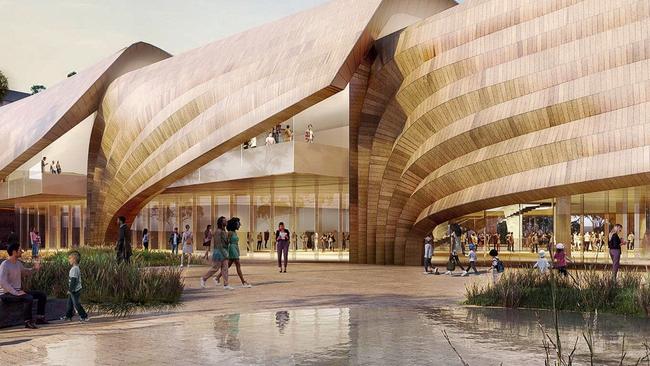
When the nation’s biggest contemporary art gallery opens in Melbourne in 2028, visitors will enter through a broad archway and into a huge central atrium in the shape of a sphere. This giant “omphalos” is the novel – or rather, given the word’s Greek origin, navel – feature of The Fox: NGV Contemporary, and it immediately captured people’s imaginations when the designs were revealed in March.

Announcing the designs, Victoria’s creative industries minister Danny Pearson compared NGV Contemporary with the Eiffel Tower – and seemed to avoid mentioning the Sydney Opera House – as an indication of his state’s ambitions to acquire a world-recognised landmark. Others saw a similarity between the new gallery and Frank Lloyd Wright’s rotunda for the Guggenheim Museum in New York, or Norman Foster’s dome on the restored Reichstag in Berlin.
The lead architect on NGV Contemporary, Angelo Candalepas, offers several antecedents for his spherical solution, including the dome of the Roman Pantheon and the cenotaph for Isaac Newton imagined by Etienne-Louis Boullée in the 18th century. Having Greek heritage, he was also attracted to the idea of an omphalos as the “navel of the world”. It refers to ancient Delphi and the temple where the Oracle, in a drug-induced trance, would make her predictions.
Candalepas thinks of contemporary artists as modern-day soothsayers, and NGV Contemporary’s omphalos as a place the public will come to experience and contemplate modern visions of the world.
“It’s where people can consider what is being uttered by the philosophers of our time – the artists of our time – as predictions of the future,” he says. “I think of it as a parallel to the ancient Delphi.”
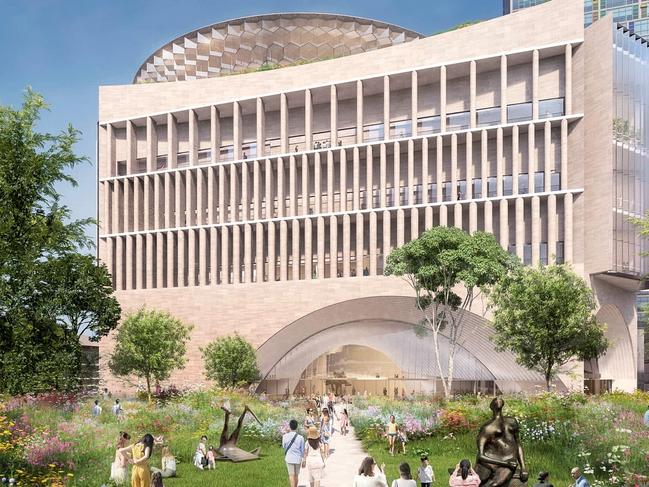
One prediction, and not a hard one to make, is that Australians are about to experience a whole new range of cultural buildings that are transforming our cities, not just Melbourne, and adding attractions to the regions.
A cultural building boom is under way, as growing population centres cement their cultural roots with new facilities, older buildings are brought up to speed with the expectations of modern audiences, and high-achieving arts organisations move into purpose-built facilities that match their aspirations. Taking into account newly announced projects, those under construction, and others that have opened within the past two years, the arts infrastructure bonanza is worth more than $5bn.
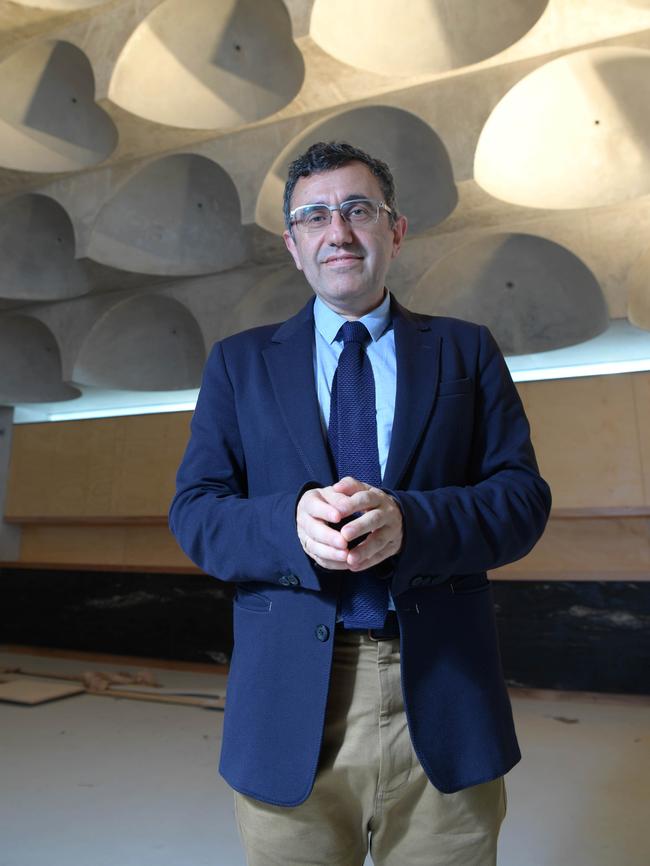
New galleries and cultural precincts are the big-budget items. The cost of NGV Contemporary has not been disclosed, but it is part of the redevelopment of Melbourne Arts Precinct, including upgrades at the neighbouring Arts Centre and other works, for which the Victorian government has budgeted $1.7bn. It is the nation’s single biggest cultural spend.
But Sydney, where current and recent projects are worth more than $2bn, is the epicentre of the building boom. The city is making up for lost time, as cultural building has not kept pace with a growing population or adequately replaced older facilities that were repurposed or knocked down. Sydney Modern, a new building for the Art Gallery of NSW, designed by Japanese firm SANAA, is due to open in December this year. People walking past the construction site in the Domain can see the top of the entry pavilion and the glazing that already has been installed. The $344m gallery takes the form of a series of pavilions that step down from the Domain to Woolloomooloo. When it opens later this year, Sydney Modern will include a new exhibition space dedicated to Indigenous art, a sculpture garden, and a subterranean gallery for contemporary art in repurposed World War II oil tanks.
Other parts of the city are also being transformed. The Walsh Bay Arts Precinct recently opened after a $370m redevelopment of two heritage wharves on the harbour. As well as a newly remodelled Wharf Theatre for Sydney Theatre Company, the precinct includes purpose-built facilities for the Australian Chamber Orchestra, Bell Shakespeare and Australian Theatre for Young People.

The Sydney Opera House will crown a decade-long program of upgrades with the opening in July of the refurbished Concert Hall. The most substantial intervention to Jørn Utzon’s building since it opened in 1973 will improve visitor access to the Concert Hall and hopefully fix its maligned acoustics.
Venue upgrades are also happening at the Carriageworks arts centre; the curtain has gone up on the refurbished Theatre Royal; and the Australian Museum has opened its new extension, including a temporary exhibition gallery.
By far the largest cultural spend in Sydney is the Powerhouse Museum, a behemoth project that now includes a new building at Parramatta as well as an overhaul of its historic site in inner-city Ultimo. With a total expenditure of about $950m, the Powerhouse project has aroused strong passions over the cost, the new museum’s site on a flood plain at Parramatta, the removal of a heritage building there, and the feared closure of the existing Ultimo site. While the government has backflipped on Ultimo and the museum will retain a presence there, detailed plans of the upgrades have not been announced.
New facilities are being put down in each of the major state capitals. Queensland Ballet is expanding its property portfolio in Brisbane, where a major upgrade of its home studio at the Thomas Dixon Centre is nearing completion. The Queensland Ballet Academy has opened at Kelvin Grove, and a donated parcel of land at Yatala will be used to build a production centre. Queensland Ballet will also have use of a new 1500- seat theatre under construction at the Queensland Performing Arts Centre, expected to open next year.
See The List: 100 Arts & Culture stars
In Perth, the $400m WA Museum Boola Bardip opened in late 2020, giving a much-needed boost to the city’s Northbridge cultural precinct. Adelaide has seen upgrades to the historic Her Majesty’s Theatre and the Adelaide Festival Centre precinct, although a $662m plan to replace the city’s Entertainment Centre was scrapped with the change of government in SA.
The major new cultural development in Adelaide is the Tarrkarri Centre for First Nations Cultures, a $200m standalone museum at Lot Fourteen. Built on the site of the Royal Adelaide Hospital, Lot Fourteen is a campus of cultural, entrepreneurial and scientific organisations, including digital post-production firms, defence and aerospace.
Tarrkarri will provide a home for a large collection of historic Aboriginal cultural material, some of which had been stored in a former printing works. It is one of three new centres being built to house and display Indigenous art and culture, addressing a notable absence in the nation’s stock of cultural institutions.
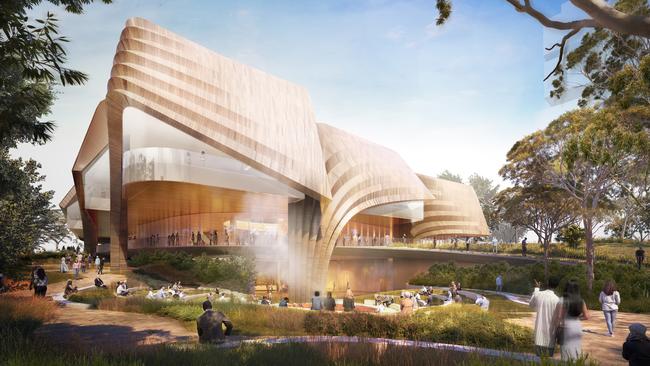
Alice Springs will gain the National Aboriginal Art Gallery after the NT government moved to acquire the Anzac Oval for the $150m development, against the wishes of traditional owners and the local council. If construction goes ahead the gallery will open in 2025.
In Canberra, the federal government has budgeted $316.5m to build Ngurra, the National Aboriginal and Torres Strait Islander precinct on the shore of Lake Burley Griffin. As well as cultural and educational facilities, including exhibition galleries, the solemn heart of Ngurra will be a final resting place for repatriated Aboriginal remains, when the ancestral country of individual remains cannot be established.
The Australian Institute of Aboriginal and Torres Strait Islander Studies has launched the first stage of an architectural competition for Ngurra – meaning home, camp or “place of belonging” – on a 35,000sq m site at the heart of the national capital. When complete, it will form part of a chain of cultural and civic institutions along Lake Burley Griffin, including the National Gallery of Australia, the High Court, and the Aboriginal Tent Embassy.
‘We shouldn’t ever stop creating public museums and public buildings, and rejuvenating our own image of ourselves through these ventures’
Most of the developments mentioned here are essentially government infrastructure projects and are substantially financed with public funds, although some also have relied on philanthropic support, as with the $100m donated by Lindsay Fox and his wife Paula towards the building of NGV Contemporary. Other projects are institutional or private investments, such as the University of Sydney’s new museum, the Chau Chak Wing Museum, housing the university’s collections of fine art, antiquities and natural history, and named for the donor, businessman Chau Chak Wing. Billionaire philanthropist Judith Neilson has commissioned remarkable architectural spaces including the White Rabbit Gallery, the Dangrove art storage facility, and a newly opened performance space, Phoenix, with a timber-lined auditorium in the shape of an irregular bell. In Melbourne, businesswoman Naomi Milgrom is turning the former Richmond Power Station into a creative industries precinct that will “support the creation, production and presentation of contemporary performance and ideas”.
Regional Australia has not missed out on the boom. At Cobar in rural NSW, Sydney composer Georges Lentz and architect Glenn Murcutt have transformed a disused water tank into the Cobar Sound Chapel. Part architectural folly, part sound installation, it exists to play a recording of a 24-hour composition by Lentz, String Quartet(s).
New galleries are popping up, and older ones are being given a makeover, in major regional cities and some out-of-the-way places. Australia’s largest regional population area, the Gold Coast, last year opened the HOTA Gallery, with a unique facade inspired by Voronoi geometry. It is part of a larger redevelopment of the Gold Coast’s cultural precinct, Home of the Arts. New galleries have also opened at Shepparton in northern Victoria, Rockhampton in Queensland, and Bowral, NSW, while Newcastle Art Gallery is undergoing a $40m facelift and expansion.
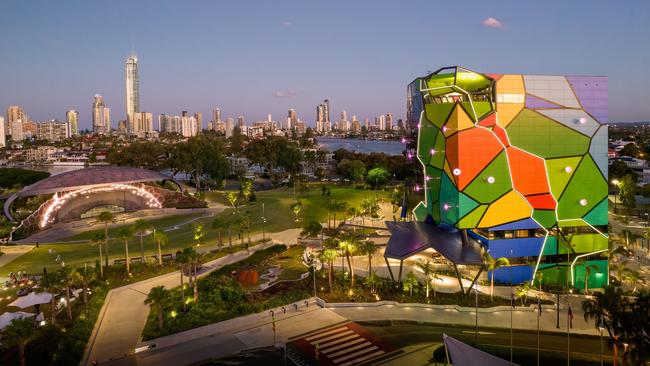
Perhaps the most remarkable regional development is at Bundanon, the 1000ha estate on the Shoalhaven River near Nowra, NSW, gifted to the nation by Arthur and Yvonne Boyd in 1993. The site has positioned itself as a destination for cultural tourism, with the building of a fire-resistant Art Museum and a 165m architectural “Bridge” across a gully with a cafe, dining area and accommodation.
The significant increase in spending on cultural infrastructure is reflected in analysis of government arts budgets (federal, state and local) between 2007-08 and 2019-20. The share of total arts expenditure for capital projects rose from 11.5 per cent in the earlier period to 17.1 per cent, according to the figures crunched by arts policy think tank A New Approach.
Candalepas, leading the architectural design for NGV Contemporary, regards cultural buildings as a symbol of a city’s dreams and aspirations. New galleries, museums, theatres and concert halls add to the sense of a city renewing itself. Born of prosperity and enlightened thinking, they make our cities and towns more exciting for residents, attractive for visitors, and inspiring for future generations.
“We shouldn’t ever stop doing it,” Candalepas says. “We shouldn’t ever stop creating public museums and public buildings, and rejuvenating our own image of ourselves through these ventures.”
Will people in years to come look back at the early 2020s as the time Australia’s mineral wealth was invested in the renewable resource of creativity and imagination? Only the Oracle can say.
